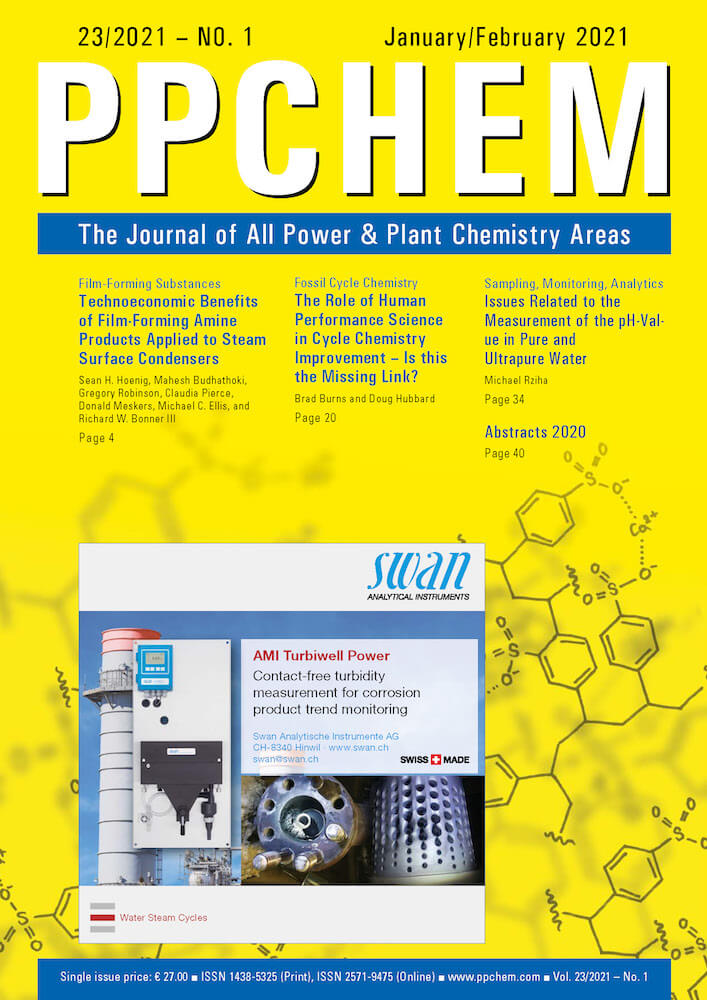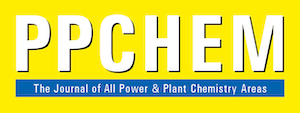
For members only
ABSTRACTS
Technoeconomic Benefits of Film-Forming Amine Products Applied to Steam Surface Condensers
Sean H. Hoenig, Mahesh Budhathoki, Gregory Robinson, Claudia Pierce, Donald Meskers, Michael C. Ellis, and Richard W. Bonner III
In a conventional Rankine cycle, the majority of power plants employ surface condensers that use pumped cooling water to reject heat from the cycle. In such cases, heat rejection occurs in a shell and tube heat exchanger by filmwise condensation of low-pressure steam on stainless steel, titanium, brass, or copper-nickel tubing. To improve the thermal performance of steam surface condensers, a replenishable film-forming substance (FFS) can be applied to the condenser tubing to promote efficient dropwise condensation. Conventionally, film-forming amine product (FFAP) coatings protect boiler surfaces from oxidative corrosion, which substantially reduces the operation and maintenance costs. To quantify the technical and economic benefits of FFAP coatings applied to condenser tubing due to the promotion of dropwise condensation, a thermal resistance network model was established. Using a representative steam surface condenser, the improvements in thermal performance (overall heat transfer coefficient) and process parameters (net plant efficiency, cooling water flowrate, and turbine backpressure) were determined due to the enhancement in the condensation heat transfer coefficient. Experimentally measured condensation heat transfer coefficients for common condenser materials were compared with the modeling results and were found to be within attainable bounds. Finally, the trend in total heat exchanger cost reduction is generalized to understand the trade-off between reduced surface area for heat rejection and increase in coating application costs for a replenishable coating system.
PPCHEM® 2021, 23(1), 4–16
For Members only
The Role of Human Performance Science in Cycle Chemistry Improvement – Is This the Missing Link?
Brad Burns and Doug Hubbard
On most units assessed by the Electric Power Research Institute (EPRI) across the world, cycle chemistry is well controlled and good results are obtained a majority of the time. Fossil and combined cycle power plants on a global scale continue to boast higher cycle chemistry benchmarking scores, installation of new instrumentation and alarming, and management support for cycle chemistry. The exception, however, continues to be major cycle chemistry excursion events that happen infrequently, yet with great consequences.
Often, when an unmitigated major cycle chemistry upset event occurs, root cause investigations pin the event on inadequate skills or knowledge (of individuals). It is therefore believed that additional training and/or disciplinary corrective action solves the root cause of the event and will prevent poor operator response to out-of-spec chemistry from recurring.
But does this approach produce desired results? This article examines that question and offers an approach with the potential to lead your organization toward a more critical review of systems and processes where countermeasures and defenses are checked and tested to determine efficacy.
Incorporating the science of human and organizational performance into a cycle chemistry program may well be the “missing link” to obtaining true cycle water chemistry improvement by preventing chemistry-influenced damage that occurs when plant personnel don’t properly respond to acute and chronic cycle chemistry upsets.
PPCHEM® 2021, 23(1), 20–30
For Members only
Issues Related to the Measurement of the pH-Value in Pure and Ultrapure Water
Michael Rziha
In all my years working in the area of power plant chemistry, I have been repeatedly confronted with either specifications or operators requesting the measurement of the pH-value either in pure water or even in ultrapure water. This often results in useless, time consuming discussions when those “measurements” are made, where some “experts” simply compare those results versus “specifications” and request that this pH-value must be 7 ± 0.5, or something similar. When asked why this is specified for an ultrapure water (e.g. outlet mixed bed filter) with a conductivity of < 0.1 μS · cm–1, the most classic answer is we don’t know, but it is specified, hence it must be fulfilled. Consequently, those specifications and the hopeless and wrong trial to measure it will lead in many projects to costly delays and consumption of precious working hours of many people involved.
Every chemist with a sound chemical education and understanding will of course immediately understand that this measurement is not only useless (I would even say nonsense), but also unnecessary.
In this brief article, the background and scientific, chemical facts will be explained for why this measurement is dispensable.
PPCHEM® 2021, 23(1), 34–37
For Members only
2020’s Scientific and Technical Contributions
PPCHEM® 2021, 23(1), 40–45

